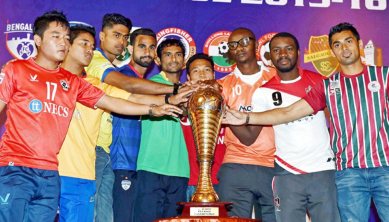Few clubs, reduced wages, unemployment: I-League turns nine
The perennially uncertain future of I-League has been a topic of intense speculation at the start of every season.

A year ago, Mehrajudin Wadoo and Subhashish Roy Chowdhury would have found themselves on the team sheet of any leading I-League clubs in the country. If not, they would have at least featured on the wish-list of the rest. But as yet another edition of the troubled tournament rolls out today, these renowned faces have instead become domestic pariahs, unable to find a club to play for.
The perennially uncertain future of I-League has been a topic of intense speculation at the start of every season. It’s no different this year as well, just that the give-two-hoots attitude of the stakeholders is now directly impacting players’ livelihood. The country’s premier domestic competition will start on Saturday with the lowest number of teams ever and highest unemployment rate among the players, a trend that underlines the stern challenges the All India Football Federation (AIFF) faces as they aim to restore the tournament’s battered image.
On the face of it, the reason for the problem seems simple — the league being reduced to nine teams from the 11 last year and the closure of several other domestic tournaments. Three clubs from last season — Pune FC, Bharat FC and Royal Wahingdoh — have decided to pull out. On an average, every club had registered a squad of 30 players which means that around 90 players from these teams suddenly found themselves without a contract.
Pune-based DSK Shivajians made a late entry to the league, giving players an option while some of them were snapped up by other clubs. But more than half of the players have so far been unable to find clubs. Several established players, including the likes of Sandesh Jhingan, Gouramangi Singh and Dhanpal Ganesh, too are yet to sign the dotted line as they are recovering from injuries. Though they have been in talks with several clubs, no one seems to be willing to gamble on an unfit player.
It might be a nightmarish scenario for the players, but from a club’s point of view it is a blessing in disguise. As is the case around the world, the Indian football transfer market has been rather inflated with many players getting a lot more than what they actually deserved, mainly because the demand for decent quality players exceeded the supply.
Clubs at an advantage
But with the number of clubs now in single digits, the tables have turned. With plenty of players to choose from, the clubs are now calling the shots. Also, the fact that the duration of the league is now just five months as opposed to eight earlier has brought down the wages considerably.
Salgaocar owner Shivanand Salgaocar said the ‘artificially created market had to burst some day’. “It is of extreme concern that so many players are without clubs because of the closure of I-League clubs. But in terms of salaries, there is a course correction occurring now,” Salgaocar said. “Earlier, players’ salaries were high primarily because some of the top clubs chased them without due diligence and only based on their past reputation. This resulted in club hopping and lack of commitment and professionalism among the players.”
The ‘course correction’ is also because of the desperation that is creeping in among the players. For instance, a national team discard who has played for top clubs in Mumbai and Goa, and would command a contract in excess of Rs 60 lakh, settled for a deal worth Rs 35 lakh this season, fearing he won’t receive offers from other clubs. “That is the case with many players this year. Apart from the top players, many of us are taking whatever is coming our way. The clubs are at an advantage in this since we do not have the negotiating power,” the player said.
AIFF vice-president Shrinivas Dempo, owner of Dempo and co-owner of ISL side FC Goa, said the trend underlined the importance of merger between the two leagues. “It’s worrying to see so many players out of jobs. That is why we need to find a solution and merge the two leagues. We cannot afford to continue to exist like this,” Dempo said.